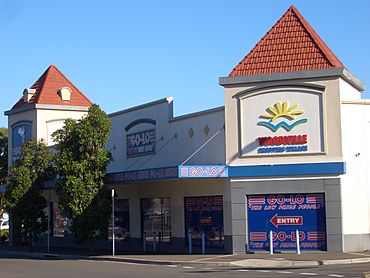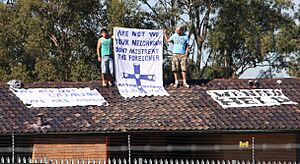Villawood, New South Wales facts for kids
Quick facts for kids VillawoodSydney, New South Wales |
|||||||||||||||
|---|---|---|---|---|---|---|---|---|---|---|---|---|---|---|---|

Woodville Shopping Village (now demolished)
|
|||||||||||||||
| Population | 6,032 (2016 census) | ||||||||||||||
| Postcode(s) | 2163 | ||||||||||||||
| Elevation | 25 m (82 ft) | ||||||||||||||
| Location | 27 km (17 mi) west of Sydney CBD | ||||||||||||||
| LGA(s) |
|
||||||||||||||
| State electorate(s) |
|
||||||||||||||
| Federal Division(s) | Blaxland | ||||||||||||||
|
|||||||||||||||
Villawood is a suburb located about 27 kilometres west of the Sydney central business district (CBD) in New South Wales, Australia. It is part of two local government areas: the City of Canterbury-Bankstown and the City of Fairfield.
Contents
History of Villawood
Long ago, the Aboriginal Gandangara tribe lived in the area that is now Villawood. European settlers started arriving in the early 1840s. By the 1860s, the land was used for farming animals, but it had a problem with many wild dogs.
The main road that goes through Villawood, Woodville Road, was actually called Dog Trap Road back then. This was because farmers set traps to catch the wild dogs. A train station opened in 1922 to serve the area. It was first named Woodville Road Station. However, there was another place called Woodville in the Hunter Valley, which caused confusion. To fix this, the name was changed to 'Villawood'.
Schools and Churches
Villawood has several places for learning and worship. You can find Villawood East Public School and Sacred Heart Primary School here. There are also centres for daily activities and community gatherings.
For religious services, there are several Christian churches. A Mosque also holds Islamic services in what used to be the old post office building on Woodville Road.
Shopping and Businesses
Villawood Place used to be a very busy shopping area for people living nearby. When a new shopping centre, Bass Hill Plaza, opened in nearby Bass Hill, many shops in Villawood became quiet. Some even closed down, leaving empty buildings.
However, Villawood Place has been updated and improved! New supermarkets, home goods stores, a bakery, chemists, and other shops have opened. This shopping area is very close to Villawood railway station.
Villawood also has a business park. This is where companies that sell hardware, furniture, auto parts, and second-hand goods are located. The Leightonfield railway station serves an industrial area in the eastern part of Villawood, where many factories and businesses operate.
Getting Around: Transport
You can travel to and from Villawood by train. Both Villawood railway station and Leightonfield railway station are on the Main Southern railway line. This line connects Villawood to other parts of Sydney.
Fun and Recreation
Villawood offers many places for sports and fun activities! The Woods Action Centre has indoor climbing, ten-pin bowling, go-karting, and even a Wiggles indoor play centre.
There are also three other main sport and recreation spots:
- The Wran Leisure Centre: Named after Neville Wran, this centre has a swimming pool, tennis courts, a gym, and squash courts.
- Thurina Park: This park has two large sports fields. They are used for soccer, cricket, and baseball. Thurina Park is also the home ground for the Villawood United Soccer Club.
- Villawood Skatepark: A great spot for skateboarding and scooter riding.
Who Lives in Villawood: Demographics
According to the 2016 census, 6,032 people lived in Villawood. Here are some interesting facts about the community:
- The average age of people in Villawood was 36 years old. This is very close to the national average of 35 years.
- About 20.1% of the population were children aged 0–14 years.
- Villawood is a very diverse place! Less than half (43.9%) of the residents were born in Australia. Many people were born in Vietnam (13.8%), Lebanon (7.4%), China (2.6%), New Zealand (2.5%), and Iraq (1.8%).
- When people were asked about their family background (ancestry), the most common answers were Lebanese (15.1%), Vietnamese (14.5%), Australian (10.8%), English (9.3%), and Chinese (6.9%).
- Less than one-third (26.0%) of people spoke English at home. Other languages spoken often included Arabic (22.0%) and Vietnamese (17.1%).
- The most common religion reported was Islam, at 25.5%.
Immigration Detention Centre
Villawood is home to the Villawood Immigration Detention Centre, located at 15 Birmingham Avenue. This place was first built in 1949 as a hostel to help people who came to Australia as post-war refugees from Europe.
Later, in 1976, part of the original camp was turned into an immigration detention centre. This centre is a place where people who are waiting for their immigration status to be decided might stay. This includes people seeking asylum or those who were not allowed to enter the country at airports or seaports.
There have been discussions and concerns raised about the conditions and how people are treated there. For example, in 2008, the Human Rights and Equal Opportunity Commission (HREOC) stated that a high-security part of the centre felt very much like a prison and suggested it should be closed.


